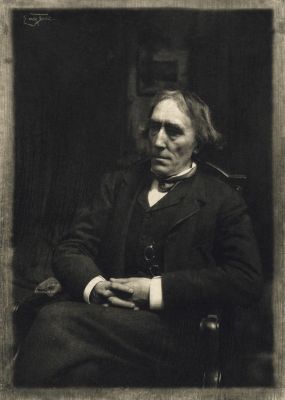
Title
Sir Henry IrvingArtist
Eugene, Frank (American, 1865-1936)Publication
Camera Work XXXDate
1910Process
PhotogravureAtelier
F. Bruckmann Verlag, MunichImage Size
12.5 x 17.5 cm
Born Frank Eugene Smith to German immigrants in New York, Frank Eugene (as he was professionally known) trained as a painter at the Royal Academy of Fine Art in Munich. Returning to New York, he took up photography to aid in the execution of his painted portraits, and by 1899 he had advanced sufficiently to exhibit 77 photographs at the New York Camera Club. In 1900, Stieglitz dedicated an issue of Camera Notes to Eugene, and he was elected to the Brotherhood of the Linked Ring, a Pictorialist photographic society in London; two years later, he was among the founding members of the Photo-Secession. In 1906, Eugene moved to Germany, where he continued to paint, photograph, and work in other media. He and Stieglitz remained close friends, mutual admirers, and artistic colleagues.
Eugene was acclaimed for incorporating painterly techniques into his photographs and photogravures, which were largely confined to portraits and nudes. The critic Sadakichi Hartmann called him a painter-photographer in an underhanded compliment, praising his composition while slighting his technical skills. It is a great pity, Hartmann wrote, that the majority of artistic photographers are as deficient in artistic temperament as Mr. Eugene is in the technique of photography. Yet Stieglitz applauded Eugene’s work, especially his platinum prints on Japanese tissue paper, and included him in exhibitions and in several issues of Camera Work. [1]
Reproduced / Exhibited
Witkin, , London, and Shestack. The Photograph Collector’s Guide. London: Secker & Warburg, 1979. p. 104.
Pohlmann, Ulrich. Frank Eugene: The Dream of Beauty. Munich: Nazraeli Press, 1996. no. 20.
Sadakichi Hartmann, “Frank Eugene: Painter-Photographer,” The Photographic Times, No. 31 (December 1899), p. 560
References
[1] Sadakichi Hartmann, “Frank Eugene: Painter-Photographer,” The Photographic Times, No. 31 (December 1899), p. 560









